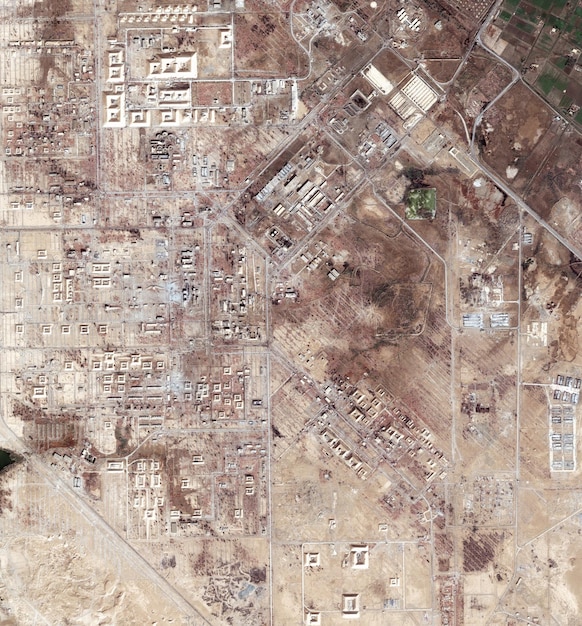US Foreign Policy in the Middle East: Interests and Conflicts

US Foreign Policy in the Middle East involves navigating complex conflicts and protecting US interests through various strategies, including diplomatic engagement, military alliances, and economic measures, while addressing regional challenges such as terrorism, political instability, and human rights concerns.
The US Foreign Policy in the Middle East: Navigating Complex Conflicts and Protecting US Interests is a multifaceted endeavor shaped by historical ties, strategic considerations, and evolving regional dynamics. Understanding this policy requires examining its objectives, instruments, and impact on the region and beyond.
Understanding the Historical Context of US Foreign Policy in the Middle East
The historical context of US foreign policy in the Middle East is crucial for understanding its present form. This section will delve into the key events and periods that have shaped the US approach to the region, highlighting significant shifts and continuities.
From early involvement in oil concessions to strategic alliances during the Cold War, the US has long been a major player in the Middle East. This involvement has been driven by a complex mix of economic, political, and security interests.
Early US Involvement and Oil Interests
The discovery of vast oil reserves in the early 20th century marked the beginning of significant US interest in the Middle East. American oil companies played a crucial role in developing these resources, leading to close ties with regional governments.
Key events included the establishment of ARAMCO (Arabian American Oil Company) and the growing reliance of the US economy on Middle Eastern oil. This dependence would shape US foreign policy for decades to come.
The Cold War and Strategic Alliances
During the Cold War, the Middle East became a battleground between the US and the Soviet Union. The US sought to contain Soviet influence by forging alliances with regional states and supporting anti-communist regimes.
- The Baghdad Pact (later CENTO) was a key alliance aimed at preventing Soviet expansion.
- Support for Israel became a cornerstone of US policy, driven by strategic and political considerations.
- The Eisenhower Doctrine pledged US support to Middle Eastern countries threatened by communist aggression.
These alliances and interventions laid the groundwork for the US’s long-term presence in the region. Understanding this historical context is essential for grasping the complexities of contemporary US foreign policy.
In conclusion, the historical context of US foreign policy in the Middle East reveals a long-standing engagement driven by oil interests and strategic considerations during the Cold War, setting the stage for current policies.

Key Objectives of US Foreign Policy in the Middle East
The key objectives of US foreign policy in the Middle East are varied and often interwoven. This section will break down the primary goals that guide US actions in the region, from ensuring energy security to promoting regional stability.
These objectives are not always aligned, leading to complex and sometimes contradictory policies. Balancing these competing interests is a constant challenge for US policymakers.
Ensuring Energy Security
Securing access to Middle Eastern oil and gas remains a vital objective for the US. While the US has become less dependent on Middle Eastern energy in recent years, the region still plays a crucial role in global energy markets.
The US seeks to ensure a stable supply of oil and gas at reasonable prices, which is essential for the health of the global economy. This involves maintaining good relations with key oil-producing countries and preventing disruptions to energy supplies.
Combating Terrorism
Combating terrorism has been a major focus of US foreign policy in the Middle East since the 9/11 attacks. The US has engaged in military interventions, counterterrorism operations, and partnerships with regional states to combat terrorist groups such as ISIS and al-Qaeda.
- Military interventions in Iraq and Afghanistan aimed to dismantle terrorist networks.
- Counterterrorism operations involve targeted strikes, intelligence gathering, and support for local forces.
- Partnerships with countries like Saudi Arabia and Jordan are crucial for sharing intelligence and coordinating counterterrorism efforts.
Despite significant progress, the threat of terrorism remains a persistent challenge in the Middle East. The US continues to adapt its counterterrorism strategies to address evolving threats.
Promoting Regional Stability
Promoting regional stability is another key objective of US foreign policy. Instability in the Middle East can have far-reaching consequences, including humanitarian crises, refugee flows, and the spread of extremism.
The US seeks to foster stability through diplomatic engagement, economic assistance, and support for political reforms. However, these efforts are often complicated by deep-seated conflicts and rivalries within the region.
In summary, US foreign policy in the Middle East is driven by several key objectives, including ensuring energy security, combating terrorism, and promoting regional stability, each presenting unique challenges and requiring careful consideration.
Instruments of US Foreign Policy in the Middle East
The instruments of US foreign policy in the Middle East are the tools and strategies used to pursue US objectives. This section will examine the various instruments employed by the US, from diplomatic engagement to military intervention.
The choice of instruments depends on the specific context and the desired outcome. The US often employs a combination of these instruments in its approach to the Middle East.
Diplomatic Engagement
Diplomatic engagement is a primary instrument of US foreign policy. This involves direct negotiations, mediation, and participation in international forums to address regional issues and promote US interests. This can range from direct dialogue to participation in multilateral efforts.
Key aspects of diplomatic engagement include maintaining embassies and consulates in regional countries, appointing special envoys to address specific issues, and participating in summits and conferences.
Economic Assistance
Economic assistance is another important instrument of US foreign policy. This includes providing financial aid, trade preferences, and investment support to promote economic development and stability in the region.
- The US provides significant financial aid to countries like Egypt and Jordan, often tied to political or economic reforms.
- Trade preferences, such as the Qualified Industrial Zones (QIZ) agreement with Jordan, aim to boost economic growth and create jobs.
- Investment support encourages US companies to invest in the Middle East, fostering economic ties and promoting development.
Economic assistance is intended to promote stability and reduce the appeal of extremism by improving economic opportunities.
Military Intervention
Military intervention is a controversial but often-used instrument of US foreign policy. This involves deploying US military forces to the region to protect US interests, combat terrorism, or promote stability.
Military interventions can range from large-scale invasions, such as the Iraq War, to targeted strikes against terrorist groups. The US also provides military assistance and training to regional partners.
The use of military force is often a last resort, but it remains a significant aspect of US foreign policy in the Middle East. This tool can sometimes be considered a double-edged sword.
In conclusion, the instruments of US foreign policy in the Middle East are diverse, ranging from diplomatic engagement and economic assistance to military intervention, each playing a crucial role in pursuing US objectives in the region.
The Impact of US Foreign Policy on Regional Conflicts
The impact of US foreign policy on regional conflicts in the Middle East is complex and multifaceted. This section will analyze how US actions have influenced various conflicts in the region, both positively and negatively.
US involvement in regional conflicts is often driven by a desire to protect its interests and promote stability. However, these interventions can have unintended consequences and exacerbate existing tensions.
The Israeli-Palestinian Conflict
The Israeli-Palestinian conflict has been a central focus of US foreign policy for decades. The US has long been a strong supporter of Israel, providing significant military and economic assistance.
The US has also played a role in the peace process, mediating between the two sides and proposing various peace plans. However, these efforts have largely failed to achieve a lasting resolution.
The Iraq War and its Aftermath
The Iraq War, launched in 2003, had a profound impact on the Middle East. The US-led invasion toppled Saddam Hussein’s regime, but it also unleashed sectarian violence and instability.
- The war led to the rise of ISIS, which controlled large swaths of territory in Iraq and Syria.
- The conflict exacerbated sectarian tensions between Sunni and Shia Muslims.
- The war also weakened the Iraqi state, creating a power vacuum that continues to fuel conflict.
The US withdrawal from Iraq in 2011 did not end the conflict. The country continues to face significant security challenges.
The Syrian Civil War
The Syrian civil war, which began in 2011, has had a devastating impact on the region. The US has supported rebel groups fighting against the Assad regime, but it has also been hesitant to intervene directly.
The conflict has drawn in regional and international powers, including Russia, Iran, and Turkey. The US has focused on combating ISIS in Syria, but it has also sought to promote a political solution to the conflict.

In conclusion, US foreign policy has had a significant and often complex impact on regional conflicts in the Middle East, influencing the trajectory of conflicts like the Israeli-Palestinian issue, the Iraq War, and the Syrian Civil War.
Challenges and Future Directions for US Foreign Policy
The challenges and future directions for US foreign policy in the Middle East are evolving as the region undergoes rapid changes. This section will identify the key challenges facing US policymakers and explore potential future directions for US engagement.
These challenges include dealing with rising powers, managing regional rivalries, and addressing the root causes of extremism. The future of US foreign policy will depend on how effectively these challenges are addressed.
Dealing with Rising Powers
The rise of powers like Iran and Turkey poses a significant challenge to US foreign policy. These countries are seeking to expand their influence in the region, often in ways that conflict with US interests.
The US must find ways to manage these rivalries and prevent them from escalating into open conflict. This may involve a combination of diplomatic engagement, military deterrence, and support for regional allies.
Managing Regional Rivalries
The Middle East is characterized by deep-seated rivalries between countries like Saudi Arabia and Iran, and between different ethnic and sectarian groups. These rivalries often fuel conflicts and undermine stability.
- The US must work to de-escalate these tensions and promote dialogue between rival groups.
- This may involve supporting mediation efforts, promoting economic cooperation, and addressing underlying grievances.
- The US must not become entangled in these rivalries, but rather play a constructive role in promoting peace and stability.
Managing these complex dynamics will require a nuanced understanding of the region and a willingness to engage with all parties.
Addressing the Root Causes of Extremism
Extremism remains a persistent challenge in the Middle East. The US must address the root causes of extremism, including poverty, inequality, and political repression.
This may involve supporting economic development, promoting good governance, and empowering civil society. The US must also counter extremist ideologies and narratives through education and outreach programs.
In conclusion, the future of US foreign policy in the Middle East will depend on how effectively it addresses the challenges posed by rising powers, regional rivalries, and the root causes of extremism, requiring a balanced and strategic approach.
The Role of Human Rights in US Foreign Policy
The role of human rights in US foreign policy in the Middle East is a complex and often debated topic. This section will examine how human rights considerations factor into US decision-making and the challenges of balancing human rights concerns with other strategic interests.
The US has long declared its commitment to promoting human rights around the world. However, in the Middle East, this commitment is often tempered by strategic considerations, such as maintaining alliances with authoritarian regimes.
Balancing Strategic Interests and Human Rights
The US faces a constant challenge in balancing its strategic interests with its commitment to human rights. In some cases, the US has prioritized strategic interests, such as combating terrorism or maintaining energy supplies, over human rights concerns.
For example, the US has maintained close ties with Saudi Arabia, despite its poor human rights record. This relationship is driven by strategic considerations, such as Saudi Arabia’s role as a major oil producer and a key ally in the fight against terrorism.
Promoting Human Rights through Diplomacy
The US also seeks to promote human rights through diplomatic engagement. This involves raising human rights concerns with regional governments, supporting human rights organizations, and advocating for political reforms.
- The US State Department publishes annual reports on human rights practices in each country, which serve as a basis for diplomatic engagement.
- The US provides financial support to human rights organizations working to promote democracy and protect human rights.
- The US also advocates for political reforms, such as free and fair elections, freedom of expression, and the rule of law.
However, these efforts are often met with resistance from regional governments, which view human rights activism as meddling in their internal affairs.
Sanctions and Human Rights
Sanctions are another tool used by the US to promote human rights. The US can impose sanctions on individuals or entities responsible for human rights abuses, restricting their access to the US financial system and limiting their ability to travel.
However, sanctions can also have unintended consequences, harming innocent civilians and undermining economic development. The effectiveness of sanctions as a tool for promoting human rights is often debated.
In summary, the role of human rights in US foreign policy in the Middle East is a balancing act between strategic interests and core values, utilizing diplomacy, support for human rights organizations, and sanctions with careful consideration.
| Key Point | Brief Description |
|---|---|
| 🔑 Oil Security | Ensuring access to Middle Eastern oil remains strategically vital. |
| 🛡️ Combating Terrorism | US policy focuses on counterterrorism efforts against groups like ISIS. |
| 🕊️ Regional Stability | Promoting stability via diplomacy and economic aid is a US goal. |
| 🤝 Human Rights | Balancing rights and strategic interests remains a complex challenge. |
Frequently Asked Questions
▼
The main goals include ensuring oil security, combating terrorism, promoting regional stability, and fostering a balance between human rights and strategic alliances within the area.
▼
Historically, the US engaged through oil concessions, strategic Cold War alliances, and interventions. These shaped its presence and influence across the Middle East over several decades.
▼
Military intervention is used to protect interests, counter terrorism, and stabilize regions, yet it is a contentious instrument that has unintended regional outcomes.
▼
Challenges include rising powers (Iran, Turkey), regional rivalries (Saudi Arabia vs Iran), and the need to address foundations of extremism, requiring nuanced strategic decisions.
▼
The US balances strategic, combating terrorism. Human rights factored strategically by supporting organizations, using diplomacy, implementing sanctions amid complex partnerships.
Conclusion
In conclusion, US Foreign Policy in the Middle East: Navigating Complex Conflicts and Protecting US Interests requires a delicate balance of strategic objectives, diplomatic engagement, and moral considerations. Addressing the region’s multifaceted challenges demands adaptive strategies and a commitment to fostering long-term stability and security.





